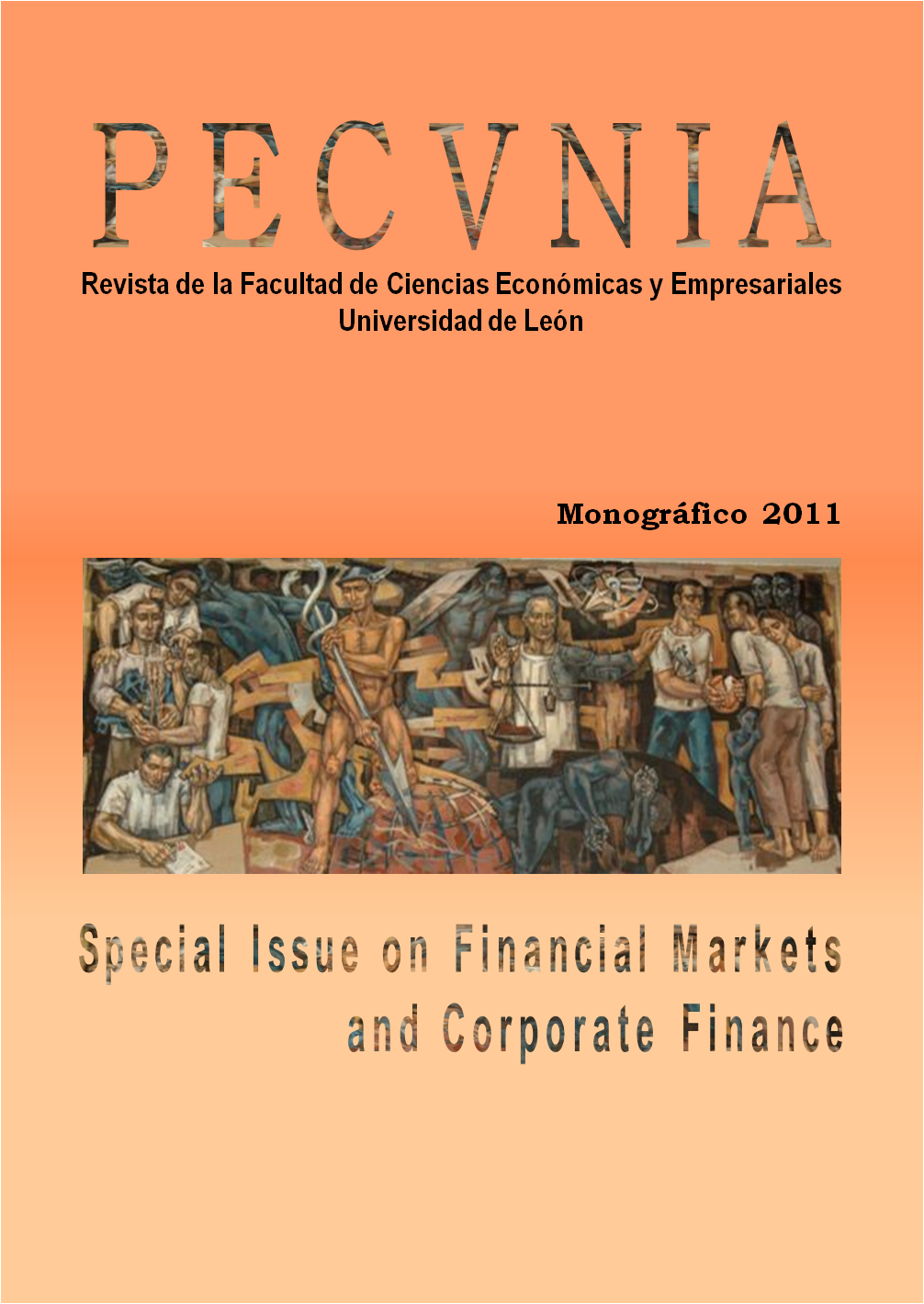Análisis de la integración y dependencia de las políticas monetarias de la Unión Europea
DOI:
https://doi.org/10.18002/pec.v0i2011.752Palavras-chave:
Política monetaria, Tipos interbancarios, Mercado interbancario, Cointegración, Monetary policy, Interbank rates, Interbank market, Cointegration, Dependence, Uncovered interest parityResumo
En este artículo se efectúa un análisis de la integración y dependencia de las políticas monetarias de la Unión Europea y, en concreto, de las políticas monetarias de la Unión Económica yMonetaria y de la zona no euro para el periodo comprendido entre Enero de 1999 y Septiembre 2009. Se aplica la metodología de la cointegración de Engle y Granger (1987) y de Johansen(1988) para contrastar la hipótesis de la paridad de tipos de interés no cubierta y se llega a la conclusión de que ambas políticas están cointegradas porque mantienen una relación de equilibrio a largo plazo. También se deduce una dependencia de la política del Banco de Inglaterra de la política del Banco Central Europeo, lo que confirma la importancia y el liderazgo de la Unión Económica y Monetaria.This study is to investigate the long-run relationship and dependence between the UME´s monetary policy and non-euro zone´s monetary policy for the period from January 4, 1999 to September 30, 2009. We use cointegration methodology to test the Uncovered Interest Parity Hypothesis and the results indicate a long-run cointegration and empirical evidence testifies a leader-follower pattern between the two central banks. According to this pattern, the Bank of England does follow the European Central Bank.
Downloads
Referências
Belke, A. y Cui, Y. (2009). “US-Euro area monetary policy interdependence. New evidence from Taylor Rule based VECMs”, Ruhr Economic Papers, 85, Universität Duisburg-Essen.
Brada, J. y Kutan, A. (2001). “The convergence of monetary policy between candidate countries and the European Union”, Economic Systems, 25 (3), pp. 215-231.
Brada, J., Kutan, A. y Zhou, S. (2005). “Real and monetary convergence between the
European Union´s core and recent member countries: A rolling cointegration approach”, Journal of Banking & Finance, 29 (1), pp. 249-270.
Bredin, D. y Fountas, S. (1998). “Testing for monetary policy convergence in European countries”, Journal of Economic Studies, 25 (5), pp. 353-369.
Buiter, W. (2008). “Why the United Kingdom should be join the eurozone”, International Finance, 11 (3), pp. 269-282.
Chaboud, A. y Wright, J. (2005). “Uncovered interest parity: it works, but not for long”, Journal of International Economics, 66 (2), pp. 349-362.
Devine, M. (1997). “The cointegration of international interest rates: A review”, Technical Paper, nº 1/RT/97, Economic Analysis, Research and Publications Department, Central Bank of Ireland.
Dickey, D.A. y Fuller, W.A. (1979). “Distribution of the estimators for autoregressive time series with a unit root”, Journal of the American Statistical Association, 74 (366), pp.427-431.
Dickey, D.A. y Fuller, W.A. (1981). “Likelihood ratio statistics for autoregressive times eries with a unit root”, Econometrica, 49 (4), pp. 1057-1072.
Dolado, J.; Gonzalo, J. y Marmol, F. (2001). “A primer in cointegration”. In, A companion to theoretical econometrics, Baltagi, B.H. (Ed.), chapter 30. New York: Blackwell.
Engle, R.F. y Granger, C.W.J. (1987). “Cointegration and error-correction: representation, estimation and testing”, Econometrica, 55 (2), pp. 251–276.
Engle, R. y Granger, C.W. (1987) “Cointegration and error correction: Representation, estimation and testing”, Econometrica, 55 (2), pp. 251-276.
Engle, R. y Granger, C.W. (1991). Long run economic relationships: Readings in cointegration, advanced texts in econometrics. Oxford: Oxford University Press.
Engle, R.F. y Yoo, B.S. (1987). “Forecasting and testing in cointegrated systems”, Journal of Econometrics, 35 (1), pp. 143-159.
Engle, R.F. (2002). “Dynamic conditional correlation: a simple class of multivariate generalized autoregressive conditional heteroskedasticity models”, Journal of Business and Economic Statistics, 20 (3), pp. 339-350.
Flam, H. et al. (2008). “EMU at ten. Should Denmark, Sweden and the UK join?, SNS Economic Policy Group Report, Stockholm.
Galindo, L.M. y Salcines, V. (2003). “Una nota sobre la hipótesis de Fisher en España en el proceso de convergencia europeo”, Momento Económico, 127, pp. 72-77.
Gerdesmeier, D. y Roffia, B. (2004). “Taylor rules for the euro area: the issue of realtime data”, Discussion Paper Series, 1 (37), Deutsche Bundesbank, Research Centre.
Granger, C.W.J. (1969). “Investigating causal relations by econometric models and cross-spectral methods”, Econometrica, 37 (3), pp. 424-438.
Granger, C.W.J. (2004). “Análisis de series temporales, cointegración y aplicaciones”, Revista Asturiana de Economía, 30, pp. 197-206.
Granger, C.W.J. y Newbold, P. (1974). “Spurious regression in econometrics”, Journal of Econometrics, 2, (2), pp. 111-120.
Granger, C.W.J. y Weiss, A.A. (1983). “Time series analysis of error-correction models”. In Studies in econometrics, time series and multivariate statistics, Karlin, S.; Amemiya, T. y Goodman, L.A. (Eds.). En honor de T.W. Anderson. San Diego: Academic Press, pp. 255-278.
Granger, C.W.J. y Lee, T.-H. (1990). “Multicointegration”. In Advances in econometrics: cointegration, spurious regressions and unit roots, Rhodes, G. F. y Fomby, T.B. (Eds.). New York: JAI Press, pp. 17-84.
Guisán, M.C. (2008). “Causalidad y cointegración en modelos econométricos: aplicaciones a los países de la OCDE y limitaciones de los tests de cointegración”, Working Paper Series Economic Development, nº. 61, Facultad de Ciencias Económicas y Empresariales, Universidad de Santiago de Compostela.
Hall, A.D.; Anderson, H.M. y Granger, C.W.J. (1992). “A cointegration analysis of treasury bill yields”, Review of Economics and Statistics, 74 (1), pp. 116-126.
Hansen, P.R. y Johansen, S. (1998). Workbook on cointegration. Oxford: Oxford University Press.
Hylleberg, S. et al. (1990). “Seasonal integration and cointegration”, Journal of Econometrics, 44 (1-2), pp. 15-238.
Holtemoller, O.(2005). “Uncovered interest rate parity and analysis of monetary convergence of potential EMU accession countries”, International Economics and Economic Policy, 2 (1), pp. 33-63.
Jaén García, M. y López Ruíz, E. (2001). Modelos econométricos de series temporales: teoría y práctica. Oviedo: Septem Ediciones.
Johansen, S. (1988) “Statistical analysis of cointegration vectors”, Journal of Economic Dynamics and Control, 12 (2-3), pp. 231-254.
Johansen, S. y Juselius, K. (1990). “Maximum likelihood estimation and Inferences on cointegration with applications to the demand for money”, Oxford Bulletin of Economics and Statistics, 52 (2), pp. 169-210.
Johansen, S. (1991). “Estimation and hypothesis testing of cointegration vectors in gaussian vector autoregressive models”, Econometrica, 59 (6), pp. 1551-1580.
Johansen, S. (1995). Likelihood-based inference in cointegrated vector autoregressive models (Advanced tests in Econometrics). Oxford: Oxford University Press.
Karfakis, J.C. y Demetrios, M.M. (1990). “Interest rate linkages within the European monetary system: A time series analysis”, Journal of Money, Credit and Banking, vol. 22, nº 3, pp. 388-394.
Kasman, A.; Kirbas-Kasman, S. y Turgutlu, E. (2008). “Monetary policy convergence of potential EMU accession countries: A cointegration analysis with shifting regimes”, Economic Modelling, 25 (2), pp. 340-350.
Katsimbris, G. y Miller, S. (1993). “Interest rate linkages within the european monetary system: further analysis”, Journal of Money, Credit and Banking, 25 (4), pp. 771-779.
Kiymaz, H. y Waller, E. (2002). “Cointegration between short-term international interest rates”, WallerJournal of Accounting & Finance Research, 12 (6), pp. 11-21.
Kocenda, E.; Kutan, A.M. y Yigit, T.M. (2006). ”Pilgrims to the eurozone: how far, how fast?, Economic Systems, 30 (4), pp. 311-327.
Lardic, S. y Mignon, V. (2003). “Fractional cointegration between nominal interest rates and inflation: a re-examination of the fisher relationship in the G7 countries”, Economics Bulletin, 3 (14), pp. 1-10.
Mackinnon, J.G.(1996). “Numerical distribution functions for unit root and cointegration tests”, Journal of Applied Econometrics, 11 (6), pp. 601-618.
Maddala, G.S. y Kim, I. (2002). Unit roots, cointegration, and structural changes. Cambridge, Cambridge University Press.
Mishkin, F.S. (1992). “Is the Fisher effect for real?: A reexamination of the relationship between inflation and interest rates”, Journal of Monetary Economics, 30 (2), pp. 195-215.
Pesaran, M.H.; Smith, L.V. y Smith, R.P. (2007). “What if the UK or Sweden had joined the Euro in 1999? An empirical evaluation using a global VAR”, International Journal of Finance & Economics, 12 (1), pp. 55-87.
Philips, P. (1986). “Understanding spurious regression in econometrics”, Journal of Econometrics, 33 (3), pp. 311-340.
Reade, J. y Volz, U. (2009a). “Leader of the Pack? German monetary dominance in Europe prior to EMU”, Economic Series Working Papers, Department of Economics, 419, University of Oxford.
Reade, J. y Volz, U. (2009b). “Too much to lose, or more to gain? Should Sweden join the euro?”, Discussion Paper Series, Department of Economics, 442, august.
Sander, H. y Kleimeier, S. (2006). ”Convergence of interest rate pass-through in a wider Eurozone?”, Economic Systems, 30 (4), pp. 405-423.
Sørensen, C. y Werner, T. (2006). “Bank interest rate pass-through in the euro area: A cross country comparison”, European Central Bank Working Paper, 580.
Weber, E. (2005). “British interest rate convergence between the US and Europe: A recursive cointegration analysis”, The ICFAI Journal of Monetary Economics, 4 (4), pp. 29-47.
Downloads
Publicado
Como Citar
Edição
Seção
Licença
Copyright (c) 2013 María del Carmen González Velasco, Roque Brinckmann

Este trabalho está licenciado sob uma licença Creative Commons Attribution-NonCommercial-ShareAlike 4.0 International License.
Los autores que publican en esta revista están de acuerdo con los siguientes términos:- Los autores ceden de forma no exclusiva los derechos de explotación (reproducción, distribución, comunicación pública, transformación) a la Universidad de León, por lo que pueden establecer, por separado, acuerdos adicionales para la distribución no exclusiva de la versión de la obra publicada en la revista (por ejemplo, alojarlo en un repositorio institucional o publicarlo en un libro), con un reconocimiento de su publicación inicial en esta revista.
- Este trabajo se encuentra bajo la Creative Commons Attribution-NonCommercial-ShareAlike 4.0 International License. Puede consultarse desde aquí la versión informativa y el texto legal de la licencia.
- Se permite y se anima a los autores a difundir electrónicamente las versiones pre-print (versión antes de ser evaluada) y/o post-print (versión evaluada y aceptada para su publicación) de sus obras antes de su publicación, ya que favorece su circulación y difusión más temprana y con ello un posible aumento en su citación y alcance entre la comunidad académica.












